Privacy policies might seem like a fine print detail, but they’re actually one of the most important pieces of any e-commerce business.
In today’s online world, customers are more aware than ever of the risks involved with sharing personal information credit card numbers, addresses, and even browsing habits.
Without a clear and reliable privacy policy, you’re risking not only your customers’ trust but your business’s reputation and even legal action.
Below, I’ll walk you through creating a privacy policy template that’s easy to understand, transparent, and fully compliant with regulations. We’ll cover what information you need to include, why it matters, and how to build trust with your customers.
- A clear and compliant privacy policy is a legal necessity and serves as a cornerstone for building trust and credibility in e-commerce.
- Including essential components such as data usage, security measures, and user rights ensures transparency and mitigates customer concerns about data privacy.
- Accessible placement of your privacy policy, like on the website footer or checkout page, enhances user trust and ensures compliance with regulations.
Table of Contents
PRO TIP: Take the hassle of writing your own privacy policy away with our privacy policy generator trusted by over 200,000 businesses. It’ll save you hours of work and possible costly legal mistakes.
Why Do You Need a Privacy Policy for Your E-commerce Business?
You need a privacy policy for your e-commerce business because it’s required by law for your online store. Think of it as a trust-building tool for your customers.
Any eCommerce store must include an online privacy policy if they customer data to comply with laws like the General Data Protection Regulation (GDPR) in Europe and the California Consumer Privacy Act (CCPA) or California Online Privacy Protection Act (CalOPPA) in the U.S.
Failing to comply can lead to hefty fines—up to €20 million for GDPR violations and $7,500 per violation under CCPA.
Today’s customers are savvy. According to a Pew Research study, over 79% of Americans worry about how companies use their data.
In e-commerce, where you handle sensitive information like payment details, an unclear privacy policy can damage trust and increase cart abandonment rates. Many people will simply click away if they don’t feel safe, leading to lost sales.
A clear privacy policy reassures your customers that you respect their privacy. It tells them how you handle, store, and protect their data, putting their minds at ease.
This transparency can build customer loyalty, boost conversions, and encourage positive word-of-mouth by making customers feel confident shopping with you.
I’ve seen how a lack of transparency can push customers away, which is why I always advocate being upfront about how their data is handled.
A well-written privacy policy is not just about compliance, it’s a cornerstone of customer trust and business credibility.
7 Key Components of E-commerce Privacy Policy
When creating a comprehensive privacy policy for your website, there are several key components that every e-commerce business should include.
Each element clarifies how you handle customer data, building transparency and trust.
Here’s what your privacy policy should include:
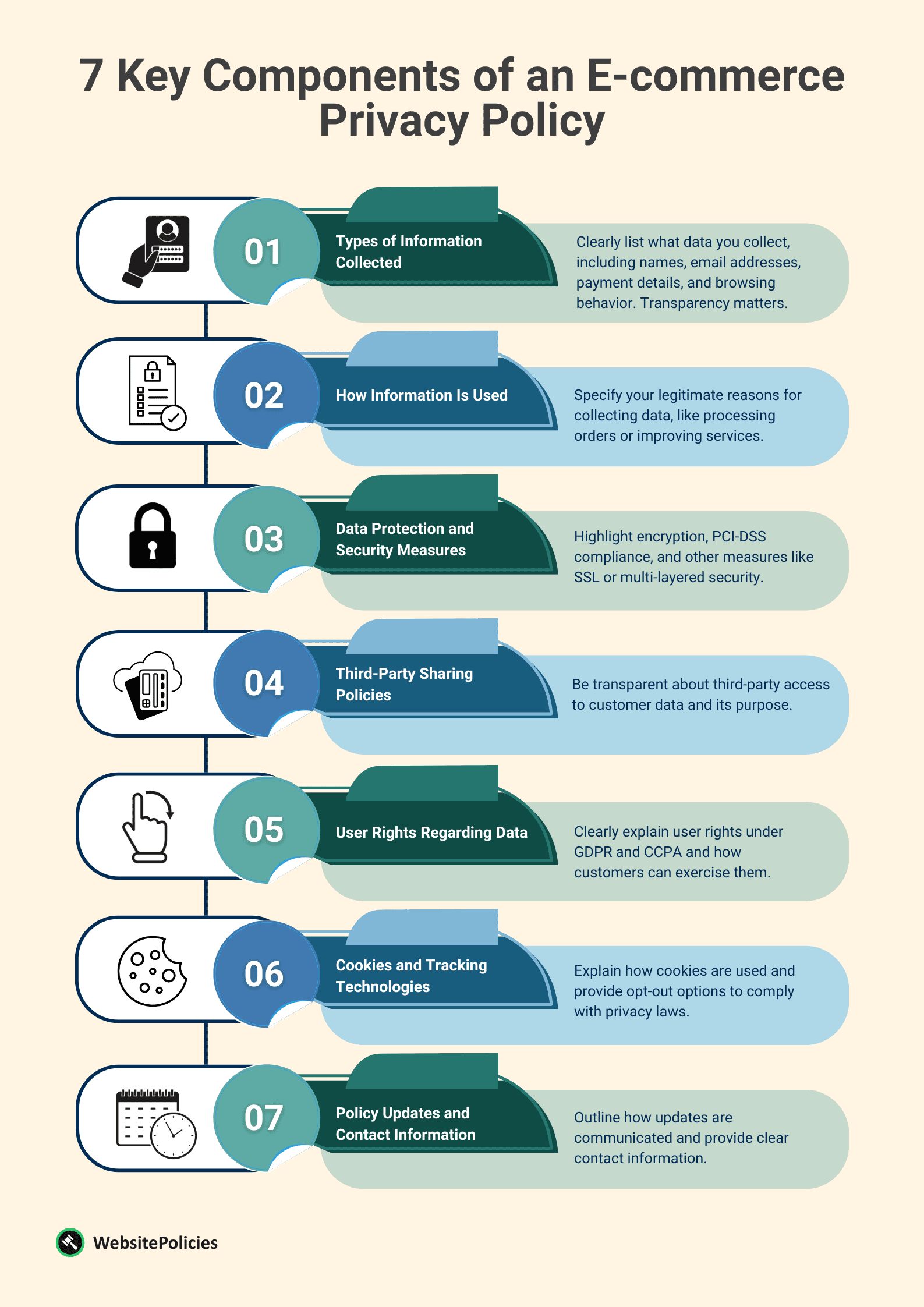
1. Types of Information Collected
Start by specifying exactly what information you collect—like names, email addresses, payment details, and browsing behavior.
This transparency is essential, as 73% of people are willing to share personal data if they feel it will be used responsibly. By laying out these details, you’re showing customers that their privacy matters to you.
2. How Information Is Used
Explain why you’re collecting this information and how it’s used. This could include processing orders, improving customer service, or marketing. Under GDPR, you’re required to have a privacy statement specifying legitimate reasons for data processing.
3. Data Protection and Security Measures
Including this clause in your privacy policy will assure customers that their data is secure by describing the measures you take to protect it, like encryption, secure payment gateways, or compliance with Payment Card Industry Data Security Standard (PCI-DSS) regulations.
Based on Baymard Institute’s 2024 survey about reasons for cart abandonment, 25% said they didn’t trust the site with their card information.
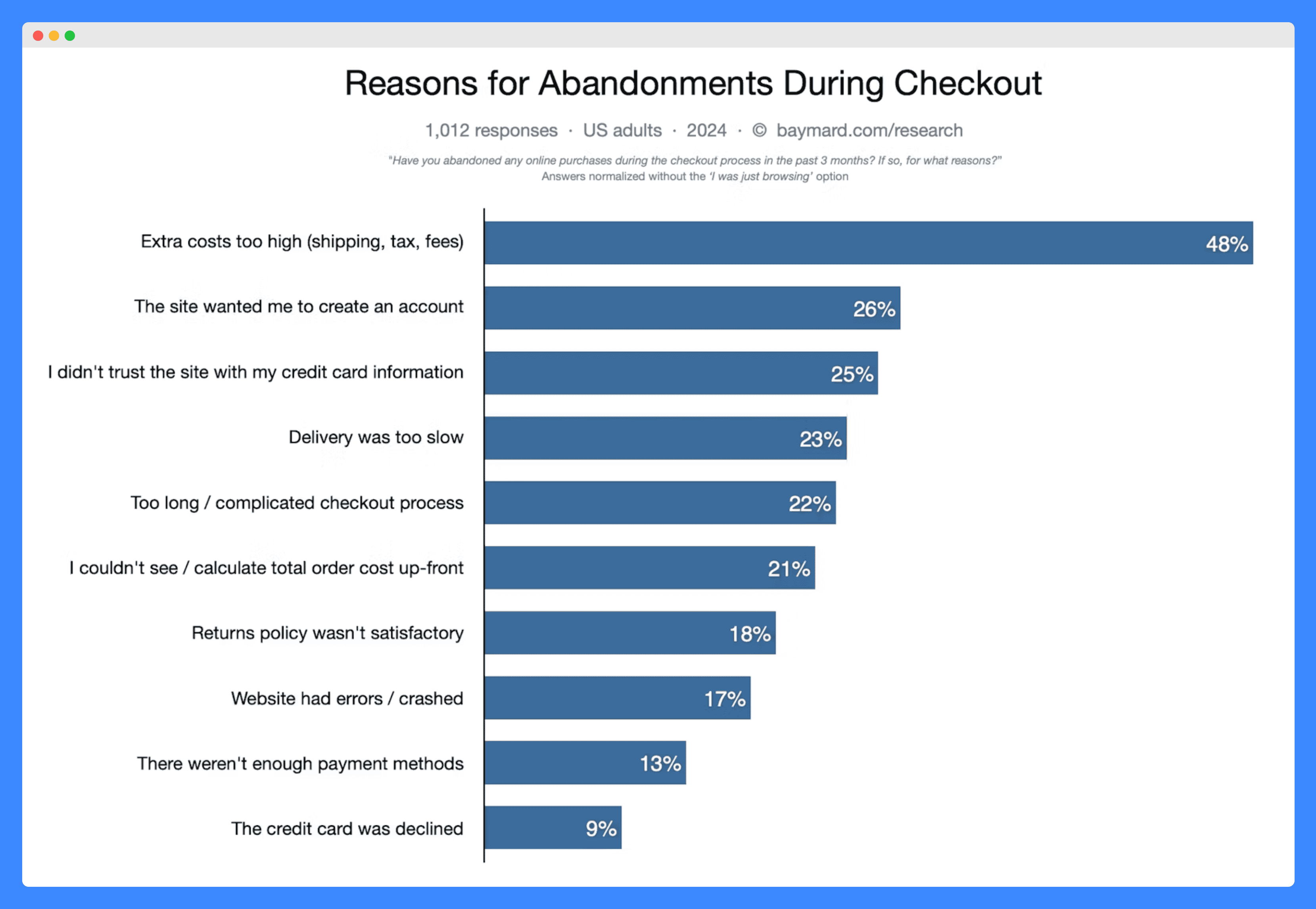
So, knowing that their information is safe may reduce this percentage.
PRO TIP: Highlight specific security protocols like SSL encryption or multi-layered security to reassure customers further.
4. Third-Party Sharing Policies
Many e-commerce stores work with third parties for payment processing, email marketing, or analytics. The CCPA requires companies to disclose third-party data-sharing practices, so be transparent about who might access your customers’ information and for what purpose.
5. User Rights Regarding Data
Inform customers and website visitors of their rights, like the right to access, update, or delete their information. Under GDPR and CCPA, users have rights to data access, correction, and deletion, and you must clearly outline how customers can exercise these rights.
Costco’s privacy policy is a strong example of user rights because it clearly outlines customers’ rights to know, correct, and delete their data, along with straightforward instructions on how to exercise these rights.
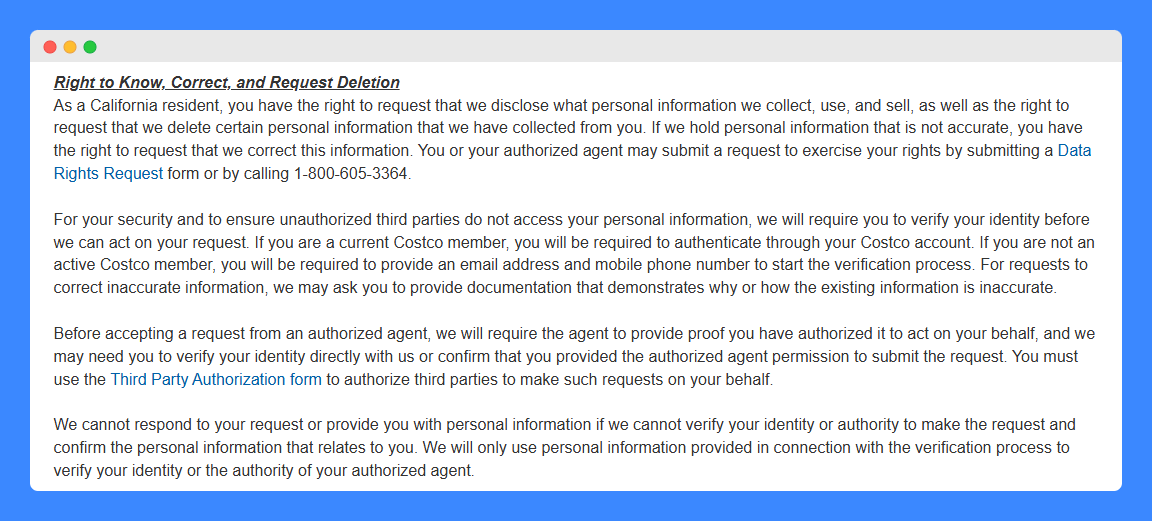
The policy also includes a verification process to ensure that only authorized individuals can access sensitive information, reinforcing security and trust.
6. Cookies and Tracking Technologies
Most e-commerce sites use cookies to enhance user experience, track behavior, or retarget customers with ads. Include a section explaining your cookie policy and how customers can opt-out.
7. Policy Updates and Contact Information
Lastly, outline how customers will be informed of any updates to your privacy policy and provide a contact option for questions or concerns. Updating your privacy policy from time to time is essential to stay compliant as data privacy laws evolve.
Nordstrom’s privacy policy is a great example of this. They clearly explain that the policy may change over time and emphasize the importance of checking for updates.
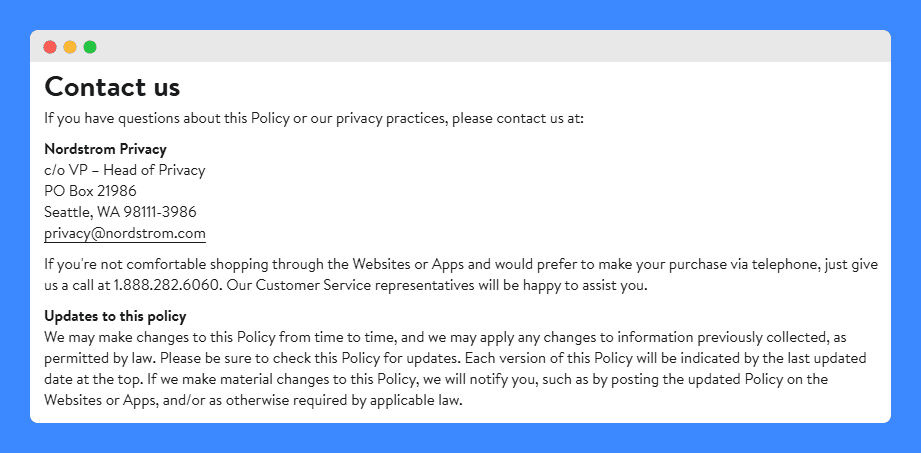
Additionally, they make it easy for customers to reach out with questions, providing multiple contact options, including an email, mailing address, and phone number.
How To Write an E-commerce Privacy Policy for Your Online Store?
Crafting an eCommerce store privacy policy that’s both legally compliant and easy for customers to understand can feel daunting.
Thankfully, there are several ways to approach it, depending on your budget, timeline, and comfort with legal language.
Let’s look at each option to help you decide what works best:
1. Hire a Lawyer
Hiring a lawyer to draft a privacy policy for your eCommerce store can be a good choice if you have complex data practices or need a highly customized document. They’ll ensure the policy is legally sound and tailored to your business specifics.
However, this can be expensive and time-consuming, which may not be practical for smaller e-commerce businesses.
2. Use a Generator
Using a privacy policy generator is a popular option for many online store owners. Generators offer a balanced approach, providing policies that are customized to fit your business while helping ensure compliance with major data protection regulations, like GDPR and CCPA.
This method is affordable, quick, and easy, and gives you peace of mind knowing the essential details are covered without needing in-depth legal expertise. Generators can also be helpful for future updates as privacy laws change.
PRO TIP: A free privacy policy generator is designed to simplify the process by guiding you through relevant questions about your data practices. If you use this, it will be easier for you to cover all necessary bases without spending a lot of time or money.
3. Use a Template
Templates are another option, especially if you need a quick fix. They can offer a solid starting point but often lack the detail or customization that many e-commerce businesses need to stay fully compliant.
If you go this route, it’s important to carefully edit the template to reflect your specific data practices. However, without a strong understanding of privacy laws, you could still miss important details.
4. Write It Yourself (Not Recommended)
Writing a privacy policy on your own may seem like a good way to save money, but privacy regulations can be tricky and require precise language. Without a legal background, it’s easy to overlook essential details, which could leave your business vulnerable to non-compliance risks.
E-commerce Privacy Policy Examples You Can Learn From
Reviewing privacy policies from established e-commerce businesses can offer valuable insights into what a comprehensive, customer-friendly policy looks like. Here are five examples from e-commerce companies known for clear, well-structured privacy policies:
1. Amazon
Amazon’s privacy policy is a solid sample because it clearly categorizes the types of personal information they collect: information users provide directly, automatic information, and information from other sources.
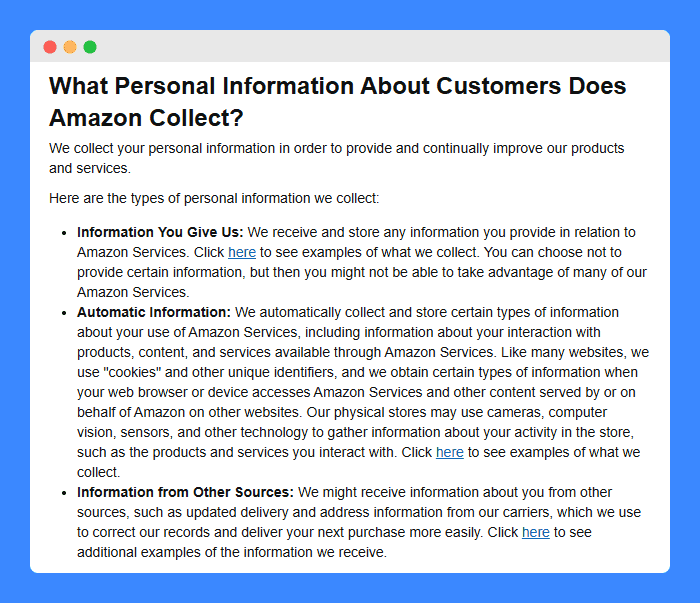
Each section is straightforward and includes specific examples, so it’s easy for customers to understand exactly what data is collected and why.
2. Etsy
This sample privacy policy by Etsy stands out because it comprehensively addresses user rights in a way that’s easy to understand, covering essential rights like access, portability, correction, restriction of processing, and deletion.
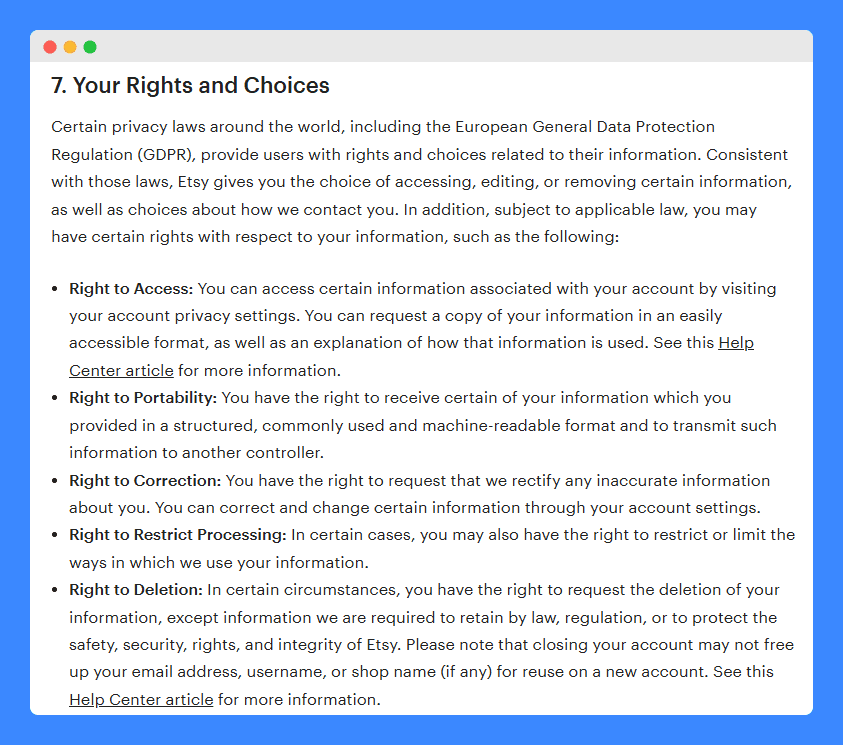
By linking these rights to GDPR and other global regulations, Etsy reinforces its commitment to data protection standards.
3. Sephora
Sephora’s privacy policy explains cookies and tracking technologies thoroughly, detailing how these tools are used for site functionality, security, analytics, and personalized advertising.
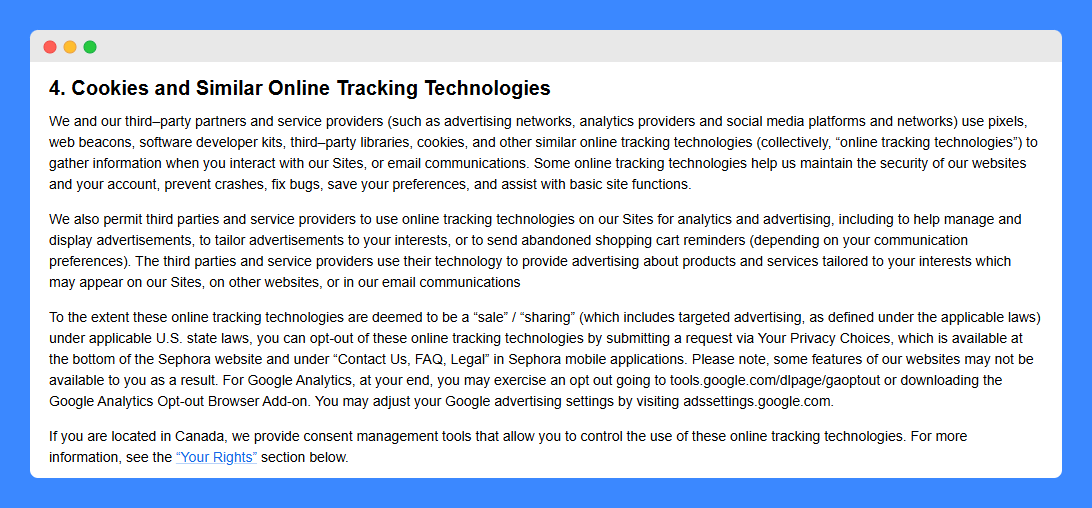
They also clarify how customers can opt out of tracking under relevant U.S. state laws and offer specific links to opt-out tools, such as Google Analytics settings.
4. Chewy
Chewy’s privacy policy is effective because it sets clear expectations right from the start, outlining what types of personal information may be collected both online and offline.
The policy explains the scope of data collection across various channels, such as websites, apps, and in-person services, which is particularly relevant for companies with multiple touchpoints.

By defining terms and including the date for a new privacy policy update, Chewy demonstrates transparency, keeps users informed about changes, and reinforces trust by showing when the policy was last reviewed.
5. Apple Store
Apple’s privacy policy is a strong example of transparency in data sharing. It clearly specifies the types of third parties Apple may share personal data with—such as service providers, partners, and developers—and outlines their specific roles and responsibilities.
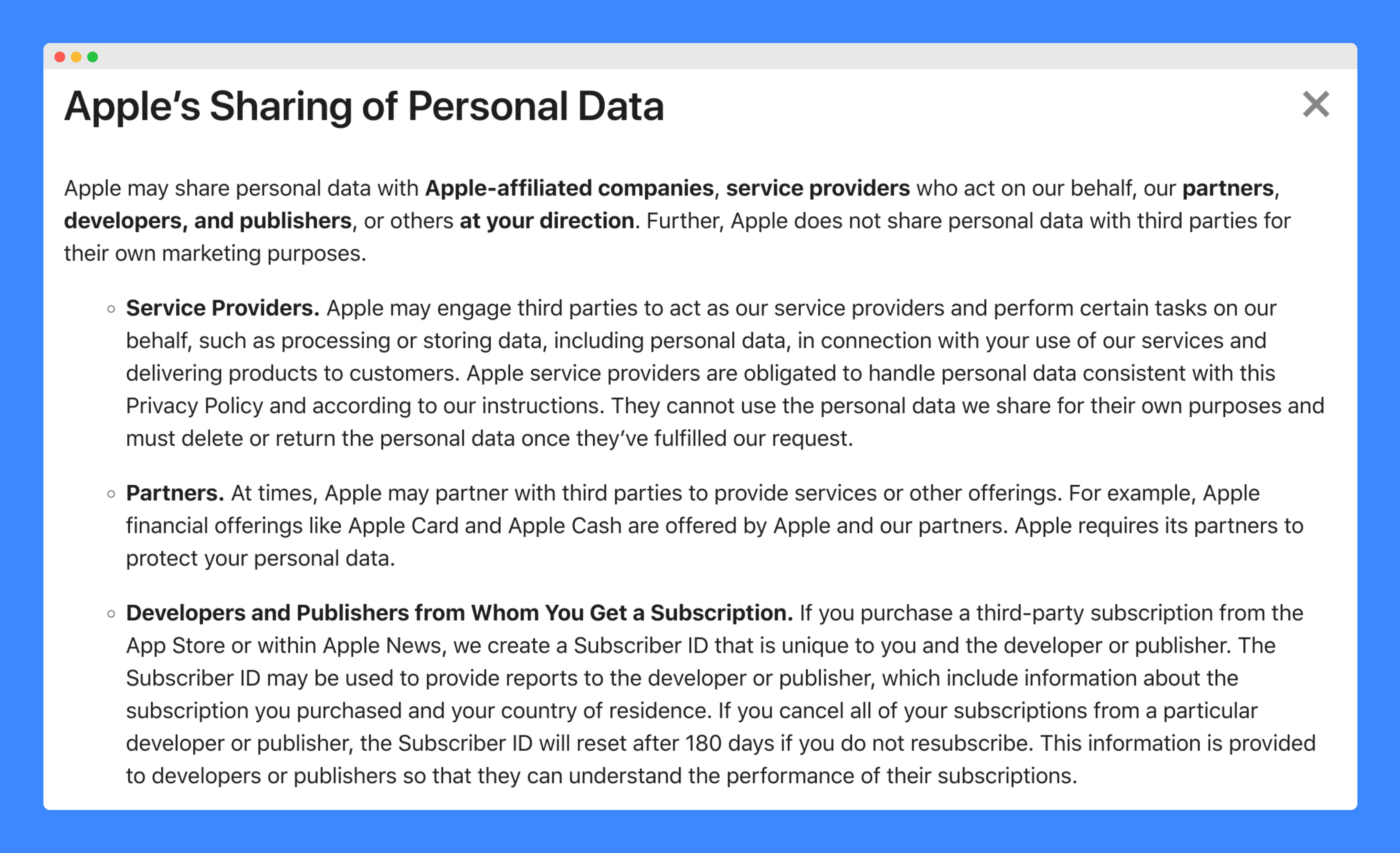
This structured and precise breakdown shows Apple’s commitment to user privacy by ensuring that data is only used for specific, authorized purposes, which enhances customer trust.
Where To Display the Privacy Policy on Your E-commerce Website?
Displaying your privacy policy in the right places on your website is essential for transparency and ease of access. Customers expect to find this information easily, especially when they’re sharing personal data. Here’s where to publish a privacy policy on your site to make it easily accessible for customers:
- Footer of Every Page: The website footer is one of the most common and accessible locations for a privacy policy link. By placing it in the footer, your privacy policy is available from any page, making it easy for customers to find it whenever they want.
- Checkout Page: This is where customers input sensitive information, like their address and payment details. Include a privacy policy page link here to reassure customers about how you handle their data, which promotes trust as they finalize their purchase.
- Account Registration/Login Page: When customers create an account or log in, they’re often asked to provide personal details. A link to your privacy policy on this page reassures them that you’re transparent about data collection practices.
- During Email Sign-Up or Newsletter Opt-Ins: Whenever you request customer data, such as email addresses for newsletters, consider adding a link to your privacy policy.
As a consumer, I get frustrated when I can’t find a privacy policy on an eCommerce website, so I’d ensure mine is accessible on every page.
PRO TIP: Ensure your privacy policy link opens in a new tab so customers don’t lose their place in the shopping process.
E-commerce Privacy Policy Template
Creating a privacy policy for your eCommerce business doesn’t have to be complicated. To make things easier, here’s a template that lays out all the key elements you’ll need to address, from data collection to user rights and security practices.
Think of it as a starting point to help you communicate clearly with customers about how you handle their information.
While this free eCommerce privacy policy template for your online store covers the basics, it’s important to adapt it to reflect your unique business practices and ensure you’re meeting all relevant legal requirements.
A well-customized privacy policy goes a long way in building trust and keeping your business protected.
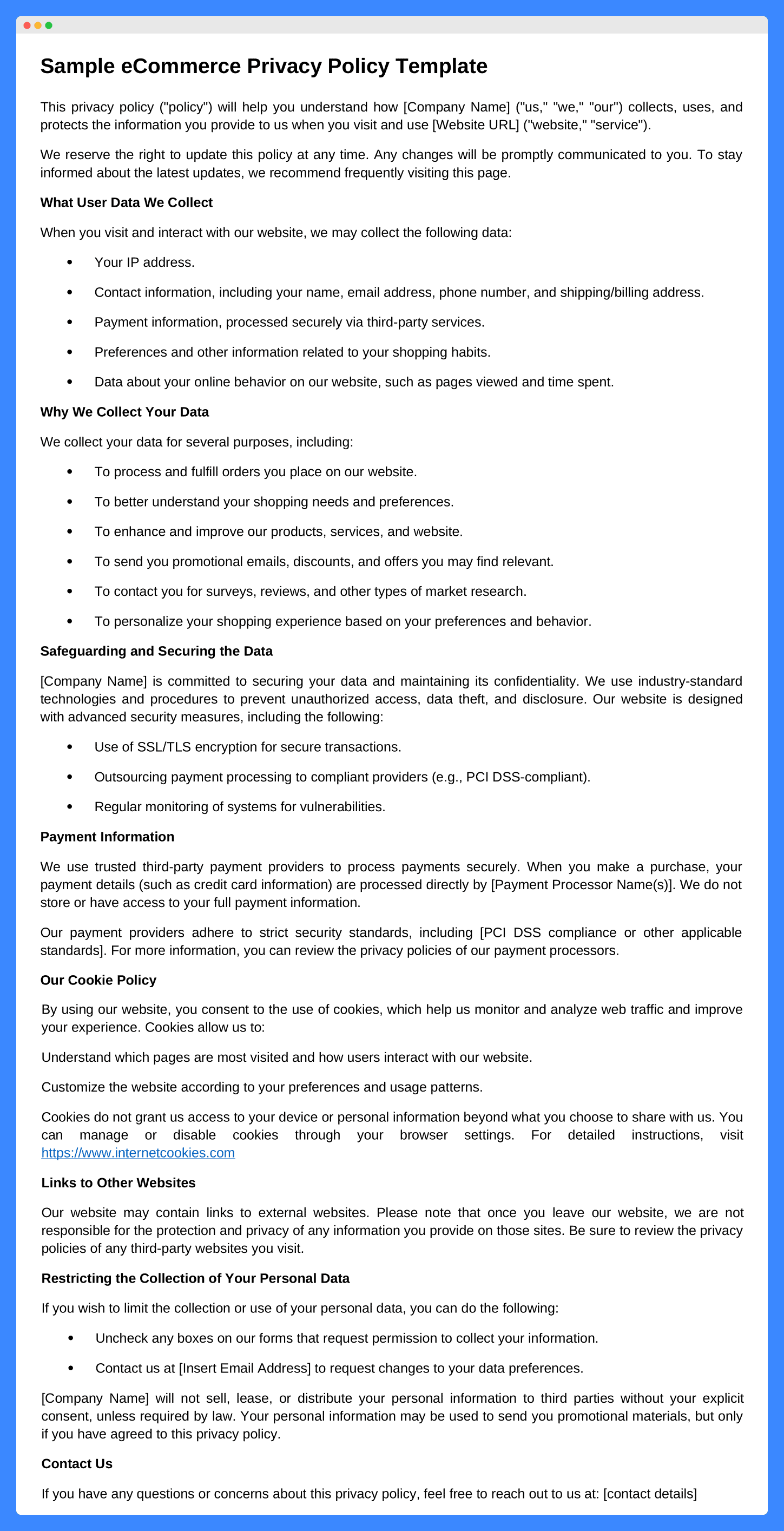
Frequently Asked Questions
How can an eCommerce privacy policy help build customer trust?
A good privacy policy reassures customers that their data is handled responsibly, boosting trust and encouraging repeat business.
Can I customize an eCommerce privacy policy template for my store’s specific needs?
Yes, templates are a great starting point, but you should tailor them to reflect your specific data collection and usage practices.
Do I need a privacy policy if my eCommerce store uses third-party payment processors?
Yes, you must disclose third-party data-sharing practices and outline how customer data is handled by external services.
Do I need a privacy policy if my eCommerce site only collects minimal customer data?
Yes, even minimal data collection requires a store privacy policy to comply with privacy laws and maintain transparency.
Can I face legal consequences if my eCommerce privacy policy is not up to date?
Yes, non-compliance with evolving privacy laws can result in fines or legal action, so regular updates are essential.



